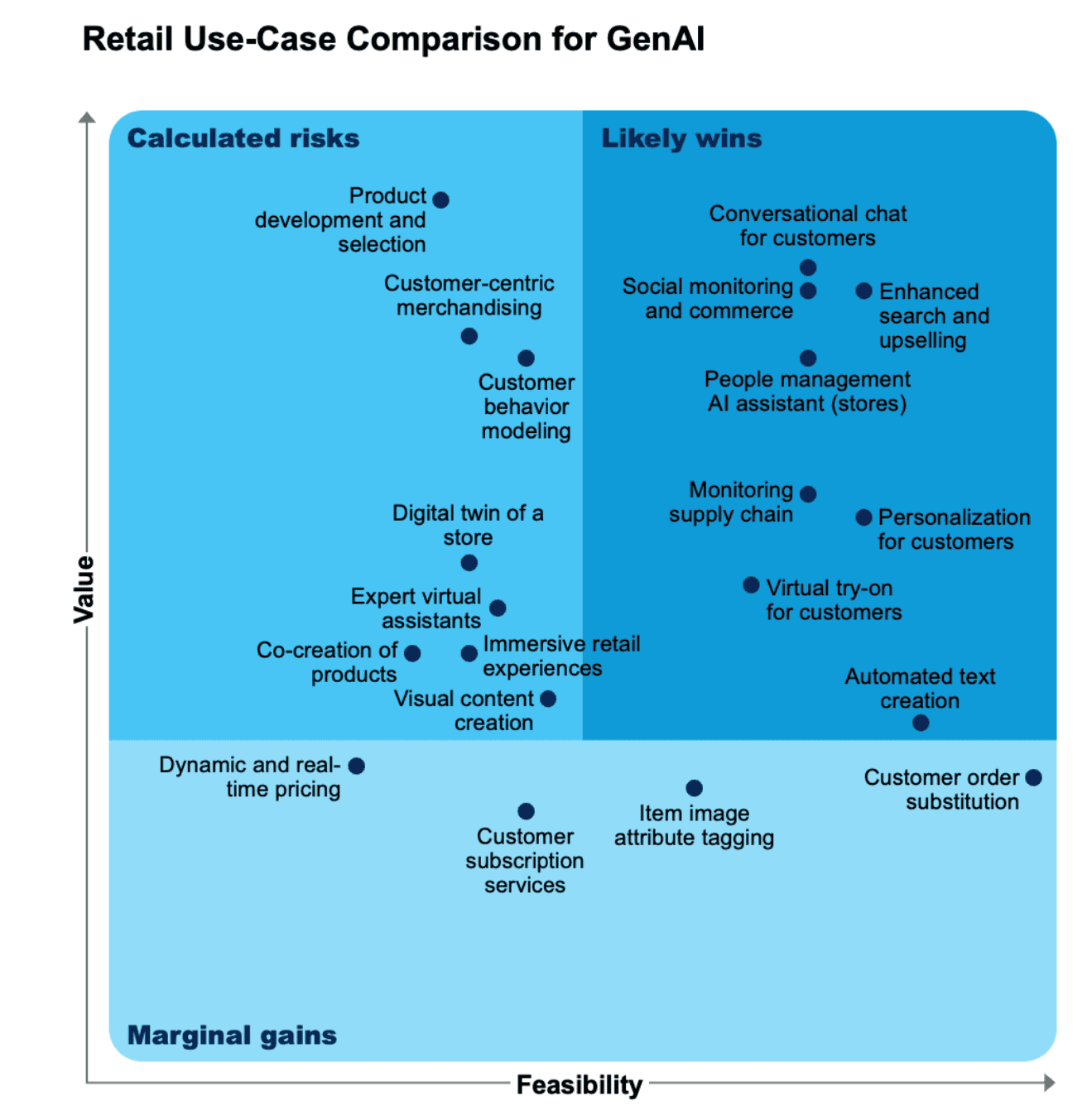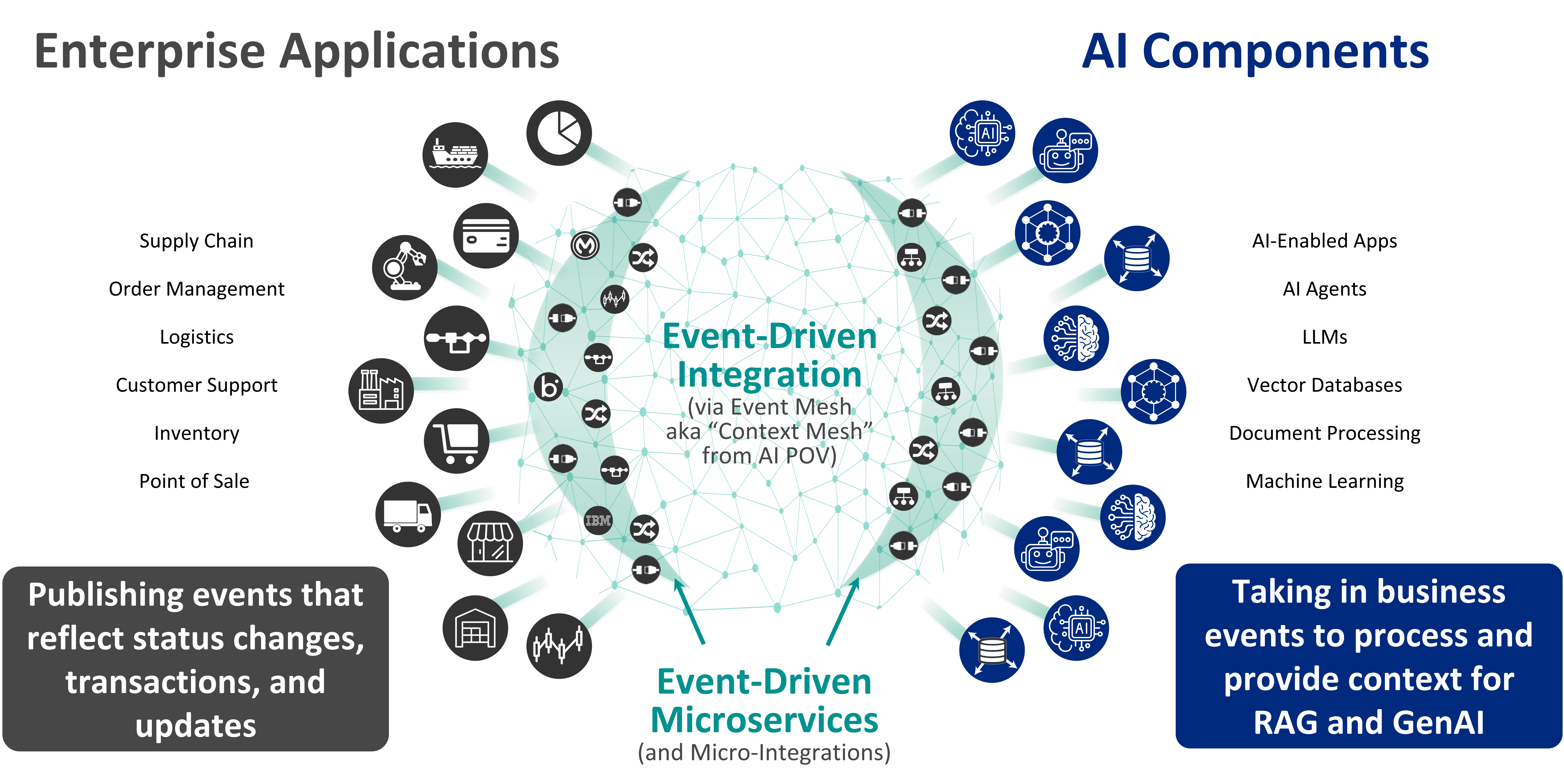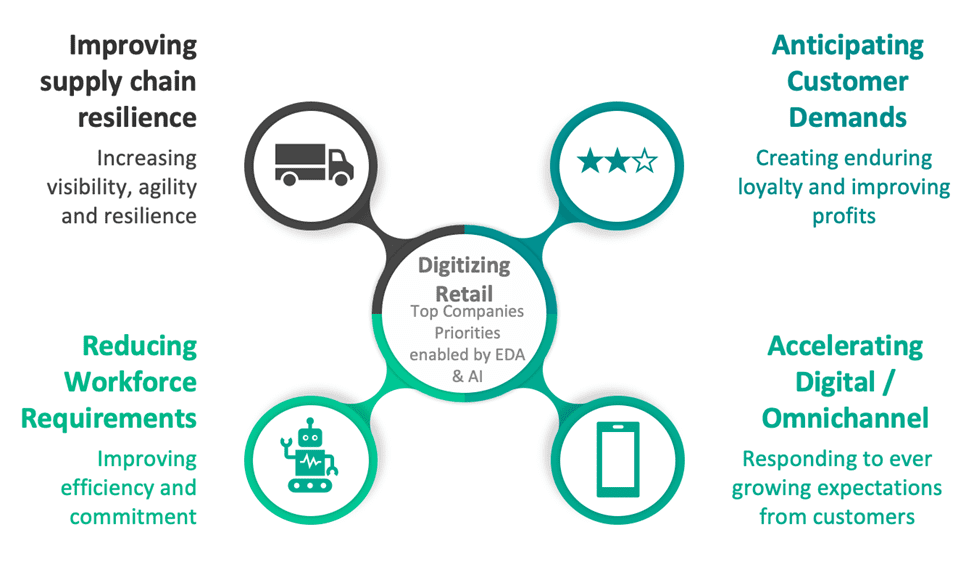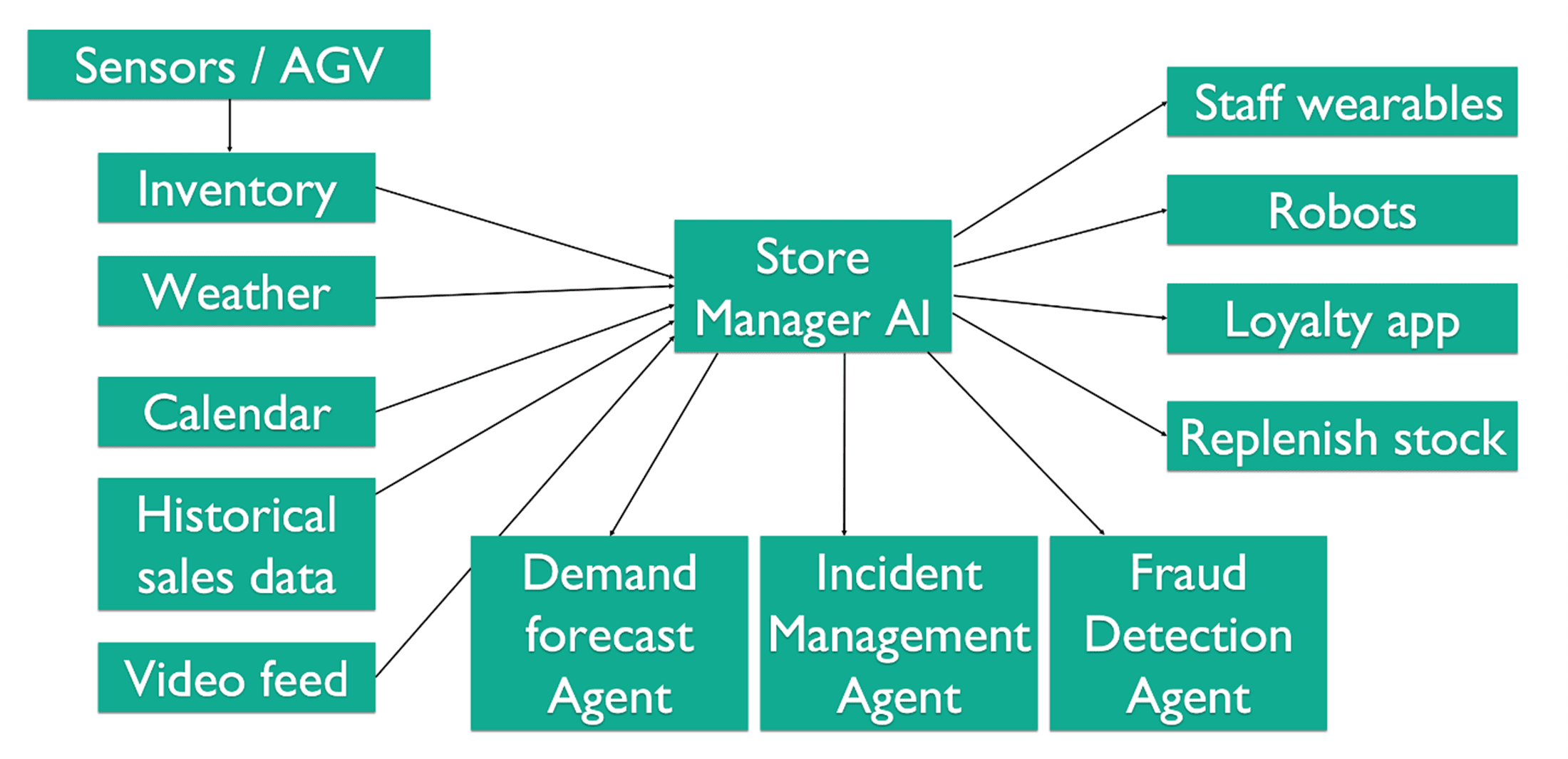Home > Blog > Artificial Intelligence
Tech pundits and industry analysts alike continue to make big promises about the potential of AI for retailers. Better customer service and better customer experiences! Intelligent inventory management for fewer stock-outs! Dynamic pricing to reduce waste!

Source: “Generative AI Use-Case Comparison for Retail”
Gartner, Inc., 11 July 2024, Robert Hetu
Gartner recently published this chart showing a variety of use cases that hinge on real-time AI.
There is definitely potential behind these promises, but actually delivering on them is deceptively difficult. Out of the box, foundational large language models (LLMs) lack the context they need to really make a difference, so retailers need to use retrieval-augmented generation (RAG) to feed real-time data (the “context”) into these systems. And for that, they need an event mesh.
How AI and Event Mesh Enable Retail Innovation
Before diving into its applications, let’s clarify what an event mesh is and how it augments AI:
Subscribe to Our Blog
Get the latest trends, solutions, and insights into the event-driven future every week.
Thanks for subscribing.
At its core, an event mesh is a network of event brokers that dynamically route events between various applications and devices across environments. It creates a dynamic, interconnected network of data, applications, and AI-powered agents across an enterprise, establishing a digital nervous system for AI that makes real-time context possible at production workloads.
Here’s how it works:
- Real-time Events: The system continuously receives events from various sources—IoT devices, point-of-sale systems, inventory databases, customer interactions, etc.
- Smart Routing: These events are then routed through the mesh to relevant applications, services, or AI agents that have subscribed to receive specific types of information using smart topics.
- AI-Powered Processing: Agentic AI, integrated into the mesh, processes these events in real-time, deriving insights and making decisions based on the current context and historical data.
- Autonomous Action: Based on the AI’s analysis or traditional rule-based systems, autonomous actions can be taken, or notifications sent to human operators, creating a responsive and efficient operational environment.
By combining real-time event streaming from various enterprise contexts with AI-driven processing, an event mesh can create a nervous system for retail operations, enabling responsiveness, efficiency, and personalization.
Addressing Top Retail Priorities with an Event Mesh and AI
The retail industry is rapidly evolving, with leaders focusing on key priorities to stay competitive. According to the Deloitte Global Retail Outlook 2024, the top four priorities for retail companies are: improving supply chain resilience (23%), anticipating and responding to changing customer demands (19%), accelerating digital transformation and omnichannel capabilities (13%), and automation and reducing workforce requirements (7%).
An event mesh, powered by agentic AI, is uniquely positioned to address these priorities. By creating a unified, real-time data network, it enhances supply chain visibility and agility, enabling quick responses to disruptions. The same system anticipates customer demands by analyzing data from various touchpoints, allowing retailers to adjust strategies rapidly. It serves as a foundation for true omnichannel capabilities, accelerating digital transformation.
Finally, by automating routine tasks and decision-making processes, an event mesh optimizes workforce requirements, freeing up human staff for high-value interactions. In essence, an event mesh creates a flexible, responsive retail ecosystem that adapts to changing market conditions, customer preferences, and technological advancements, positioning retailers to excel in all key areas of modern retail.
Real-World Applications and Tangible Benefits
Using EDA and AI together isn’t just a theory—it’s already driving value in real-world retail environments of Solace customers.
Intelligent Inventory Management
Accurate inventory management is crucial for retailers to minimize waste, prevent stockouts, and optimize supply chain operations. By automating this process, retailers can significantly reduce labor costs and human error while improving accuracy. For large retailers, this can translate to a reduction in food waste worth up to $15 million annually.
The event mesh enables this by integrating data from multiple sources in real-time. IoT devices like shelf sensors, RFID tags and AGV (automated guided vehicles) continuously generate events about stock levels. These events are routed through the mesh to AI that analyze the data, predict demand, and trigger automated restocking orders. The system can even adjust orders based on external factors like weather forecasts or local events.
The “Silent Shopping” Revolution
The concept of “silent shopping” revolves around solving operational issues and in store incidents discreetly, enhancing the customer experience by minimizing disruptions in the retail store. This approach not only improves customer satisfaction but also increases operational efficiency by allowing staff to address problems quickly and quietly.
In an event mesh implementation, various sensors throughout the store act as event generators. For instance, a temperature sensor in a refrigerator or a camera feed detecting spills using AI and then creating events. These events are immediately routed to relevant staff members’ wearable devices. AI agents within the mesh can prioritize these notifications based on urgency and staff proximity. Our colleague Ed Funnekotter recently created an excellent demonstration of this type of automated incident management system that you can read about and watch here.
Loss Prevention Reinvented
Theft prevention is a major concern for retailers, with losses potentially reaching hundreds of millions of dollars annually for large-scale operations. Advanced loss prevention systems can significantly reduce these losses while also improving the shopping experience for honest customers.
An event-driven approach to loss prevention integrates data from multiple sources in real-time. Video feeds from security cameras generate events as they detect suspicious behavior. These events are correlated with point-of-sale data and inventory tracking information within the mesh. AI agents analyze this combined data stream, identifying potential theft events with high accuracy. The system can then alert security personnel via mobile devices, providing them with relevant information and location data. This real-time, multi-source approach enabled by event-driven architecture allows for more discreet and effective loss prevention.
Omnichannel Excellence
In today’s retail environment, providing a seamless experience across all shopping channels is crucial for customer satisfaction and loyalty. An effective omnichannel strategy can lead to increased sales, improved customer retention, and a stronger brand presence.
An event mesh serves as the backbone for true omnichannel integration. It captures customer interactions as events from various touchpoints – website clicks, mobile app usage, in-store beacons, and point-of-sale systems. These events are processed in real-time, allowing AI agents to build and continuously update a comprehensive customer profile.
When a customer moves from one channel to another, the mesh ensures that their context follows them. For example, if a customer abandons an online cart and later enters a physical store, the system can notify a sales associate with product recommendations based on the customer’s online browsing history, enabling a personalized in-store experience.
The AI Store Manager
The concept of an AI store manager represents the future of retail operations, where artificial intelligence oversees and optimizes various aspects of store management. This approach can lead to significant improvements in operational efficiency, customer service, and overall store performance.
With an event mesh in place, the AI store manager acts as a central orchestrator, processing events from all store systems. It receives real-time data on foot traffic (from door sensors), stock levels (from smart shelves and Automated Guided Vehicle), staff locations (from wearable devices), and even external factors like weather (from integrated forecasting services).
The AI uses this contextual information to make decisions, such as dynamically adjusting staffing levels, optimizing store layouts, or initiating restocking processes. The mesh allows the AI manager to send instructions directly to relevant systems, AI Agents or staff members, creating a responsive and efficient store environment. As the system learns from the continuous flow of events, it can make increasingly sophisticated decisions, truly revolutionizing store management.
Smart Bakery Management
In the bakery sector, managing fresh produce efficiently is crucial for profitability and customer satisfaction. In-store bakeries face unique challenges in predicting demand, minimizing waste, and ensuring product freshness. A smart bakery management system can significantly reduce food waste, increase sales of fresh products, and improve overall customer experience by ensuring that popular items are always available.
Event mesh enables this smart bakery management by integrating various data sources and AI-driven decision making. Point-of-sale systems generate events for each transaction, while IoT sensors in display cases monitor inventory levels and product freshness. Weather data, local event information, and historical sales patterns are also fed into the mesh. AI agents process these diverse events in real-time, predicting demand for different products throughout the day.
The system can automatically adjust baking schedules, suggest dynamic pricing for items nearing the end of their shelf life, and even recommend new product combinations based on customer purchasing patterns. Staff receive real-time notifications on their mobile devices about which products to bake or restock, ensuring optimal product availability and freshness while minimizing waste.
Why an Event Mesh Matters for AI-powered Applications
The power of the event mesh lies in its ability to:
- Enable Real-Time Decision Making: By processing events as they happen in real-time, retailers can respond to changes in demand, potential issues, or opportunities instantly. The real-time context is the key ingredient here that’s missing from pre-trained AI models.
- Enhance Personalization: With access to comprehensive, real-time and contextual data, AI can deliver hyper-personalized experiences and recommendations.
- Break Down Data Silos: The event mesh ensures that valuable data doesn’t get trapped in isolated systems using Micro-Integrations across edge, on-prem and hybrid-cloud workloads, allowing for a holistic view of operational data and customer context.
- Accelerate Innovation: An event mesh enables retailers to test and deploy new ideas and experiment with new technologies like LLMs and agentic AI frameworks thanks to a loosely-coupled architecture that enables publish/subscribe communications using smart topics.
The Road Ahead
While retailers have made significant strides, there’s still work to be done. One key challenge is seamlessly identifying customers in-store without relying on manual app scans. Whether through advanced camera systems or innovative wearable technology, solving this puzzle will unlock even greater potential for personalization and efficiency. Of course, that needs to be solved with privacy concerns in mind.
As we look to the future, the integration of physical robotics with AI and the event mesh presents exciting possibilities. Just as automated guided vehicles have revolutionized warehouses, similar technologies could transform the in-store experience, from restocking shelves to assisting customers.
The Bottom Line
For senior tech and retail leaders, the message is clear: event-driven architecture and event mesh were tailor-made to solve the problems associated with scaling up complex AI applications. It is a case where two technologies are converging at the right time to deliver something that isn’t just a technological novelty — it’s a strategic imperative. The potential for cost savings, improved customer experiences, demand prediction and operational efficiencies is too significant to ignore.
As we’ve seen from real-world examples, retailers who embrace event-driven architecture and AI together are positioning themselves at the forefront of the industry. This architecture doesn’t just solve today’s challenges; it lays the groundwork for the innovations of tomorrow.
In an industry where margins are tight and competition is fierce, this approach to architecture offers a pathway to meaningful differentiation and substantial bottom-line impact. The future of retail is event-driven, AI-powered, and contextually aware. The question isn’t whether to embrace this future, but how quickly you can make it your reality.
Explore other posts from categories: Artificial Intelligence | Business | For Architects | For Developers | Retail

Ali Pourshahid is Solace's chief engineering officer, leading the engineering teams at Solace. Ali is responsible for the delivery and operation of software and cloud services at Solace, and works closely with product management on product strategy. He leads a team of incredibly talented engineers, architects, and user experience designers in this endeavor. Since joining, he's been a significant force behind Solace Cloud, Solace Event Portal, and Solace Insights products. He also played an essential role in evolving Solace's engineering methods, processes, and technology direction. Most recently, Ali has played a pivotal role in shaping and driving the company’s AI strategy, products, and adoption.
Before Solace, Ali worked at IBM and Klipfolio, building engineering teams and bringing several enterprise and cloud-native SaaS products to the market. He enjoys system design, building teams, refining processes, and focusing on great developer and product experiences. He has extensive experience in building agile product-led teams.
Ali earned his Ph.D. in Computer Science from the University of Ottawa, where he researched and developed ways to improve processes automatically. He has several cited publications and patents and was recognized as a Master Inventor at IBM.

Ben is a Technical Engineer at Solace, helping global retail enterprises gain the benefits of event driven architecture. With over 10 years experience in asynchronous system integration and messaging migration, he brings extensive experience and a passion for EDA. Before joining Solace, Ben worked within the platform integration unit for Europe’s largest retailer, and Solace customer, the Schwarz Group (Lidl & Kaufland). In his free time, Ben loves to be outside in nature especially on the mountains while hiking, cycling or freeride snowboarding.


Subscribe to Our Blog
Get the latest trends, solutions, and insights into the event-driven future every week.
Thanks for subscribing.



